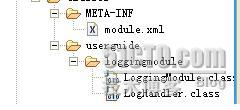1.模塊
Axis2為模塊提供一個延伸的支持。我們現在自定義一個模塊並將其部署到我 們先前創建的MyService。為一個給定的Web Service部署一個自定義的模塊,其 步驟如下:
1)建立Module Implementation。
2)創建Handlers。
3)修改"axis2.xml"。
4)修改"services.xml",使你的模塊在部署期生效。
5)將其打包為一個".mar"(Module Archive)。
6)在Axis2上部署這個模塊。
2.為MyService增加一個日志模塊
現在我們在我們的例子程序中增加一個日志模塊。這個模塊包含一個handle ,用來記錄所有傳遞給它的信息。Axis2使用". mar" (Module Archive)來部署 模塊。下圖給出了需要被打包為".mar"文檔的文件結構。

步驟一:日志模塊類
日志模塊是Axis2模塊的實現類。Axis2模塊應該實 現"org.apache.axis2.modules.Module"接口中的如下方法。
public void init(ConfigurationContext configContext, AxisModule module)
throws AxisFault;//Initialize the module
public void shutdown(AxisConfiguration axisSystem)
throws AxisFault;//End of module processing
public void engageNotify(AxisDescription axisDescription) throws AxisFault;
這些方法可以用來控制模塊的初始化和終止。通過參數AxisConfiguration, 可提供給用戶完整的配置層次。模塊設計者可以使用它來很好的控制模塊的所有 可能的操作。就這個簡單的日志服務的例子而言,我們可以空實現這些類。
LoggingModule.java
package userguide.loggingmodule;
import org.apache.axis2.AxisFault;
import org.apache.axis2.context.ConfigurationContext;
import org.apache.axis2.description.AxisDescription;
import org.apache.axis2.description.AxisModule;
import org.apache.axis2.modules.Module;
public class LoggingModule implements Module {
// initialize the module
public void init(ConfigurationContext configContext, AxisModule module) throws AxisFault {}
public void engageNotify(AxisDescription axisDescription) throws AxisFault {}
// shutdown the module
public void shutdown(ConfigurationContext configurationContext) throws AxisFault {}
public String[] getPolicyNamespaces() {
return null;
}
}
步驟二:LogHandler
Axis2中的模塊可以包含一個或多個handlers用來在不同的階段執行不同的 SOAP頭處理。創建一個handler,應該實現org.apache.axis2.engine.Handler。 但是為簡單起見,org.apache.axis2.handlers.AbstractHandler提供了一個對 Handler接口的抽象的實現。針對本例日志模塊,我們將創建一個handler包含以 下方法:
1)"public void invoke(MessageContext ctx);"//當控制權轉到handler時 ,由Axis2引擎調用。
2)"public void revoke(MessageContext ctx);"//當handlers被Axis2引擎 撤銷時調用。
package userguide.loggingmodule;
import org.apache.axis2.AxisFault;
import org.apache.axis2.context.MessageContext;
import org.apache.axis2.engine.Handler;
import org.apache.axis2.handlers.AbstractHandler;
import org.apache.commons.logging.Log;
import org.apache.commons.logging.LogFactory;
import javax.xml.namespace.QName;
@SuppressWarnings("serial")
public class LogHandler extends AbstractHandler implements Handler {
private static final Log log = LogFactory.getLog (LogHandler.class);
private QName name;
public QName getName() {
return name;
}
public void invoke(MessageContext msgContext) throws AxisFault {
log.info(msgContext.getEnvelope().toString());
}
public void revoke(MessageContext msgContext) {
log.info(msgContext.getEnvelope().toString());
}
public void setName(QName name) {
this.name = name;
}
}
步驟三:module.xml
"module.xml"包含了每一個特定的模塊的部署配置信息。它應該包含的細節 有一個實現模塊的類(本例中是"LoggingModule"和各種各樣的將在不同階段運 行的handlers)。本例中配置日志模塊的"module.xml"如下:
<module name="logging" class="userguide.loggingmodule.LoggingModule ">
<inflow>
<handler name="InFlowLogHandler" class="userguide.loggingmodule.LogHandler">
<order phase="loggingPhase" />
</handler>
</inflow>
<outflow>
<handler name="OutFlowLogHandler" class="userguide.loggingmodule.LogHandler">
<order phase="loggingPhase"/>
</handler>
</outflow>
<Outfaultflow>
<handler name="FaultOutFlowLogHandler"
class="userguide.loggingmodule.LogHandler">
<order phase="loggingPhase"/>
</handler>
</Outfaultflow>
<INfaultflow>
<handler name="FaultInFlowLogHandler"
class="userguide.loggingmodule.LogHandler">
<order phase="loggingPhase"/>
</handler>
</INfaultflow>
</module>
從這個文件中,我們可以看到"module.xml"定義了4個階段:
1)inflow-表示當一個消息到來時,這個handler鏈將運行。
2)outflow-表示當一個消息發出時,這個handler鏈將運行。
3)Outfaultflow-表示當有一個錯誤並且這個錯誤將發出時,這個handler鏈 將運行。
4)INfalutflow-表示當有一個錯誤並且這個錯誤將到來時,這個handler鏈 將運行。
下面的標簽設置描述了handler的名字,handler類和該handler將運行的階段 。
<handler name="InFlowLogHandler" class="userguide.loggingmodule.LogHandler">
<order phase="loggingPhase" />
</handler>
步驟四:修改"axis2.xml"
在這個handler中,階段"loggingPhase"是由這個模塊的設計者定義的。這不 是一個預定義的handler階段,因此該模塊的設計者應該將它在"axis2.xml"中聲 明。只有這樣,Axis2引擎才能知道將這個handler放置在哪些“流”中 (InFlow, OutFlow,等)。下面的xml定義展示了需要將日志模塊部署到Axis2引 擎而對axis2.xml作的修改。(This is an extract of the phase section of the "axis2.xml".)
<!-- ================================================= -- >
<!-- Phases -->
<!-- ================================================= -->
<phaseOrder type="inflow">
<!-- System pre defined phases -->
<phase name="TransportIn"/>
<phase name="PreDispatch"/>
<phase name="Dispatch" class="org.apache.axis2.engine.DispatchPhase">
<handler name="AddressingBasedDispatcher"
class="org.apache.axis2.engine.AddressingBasedDispatcher">
<order phase="Dispatch"/>
</handler>
<handler name="RequestURIBasedDispatcher"
class="org.apache.axis2.engine.RequestURIBasedDispatcher">
<order phase="Dispatch"/>
</handler>
<handler name="SOAPActionBasedDispatcher"
class="org.apache.axis2.engine.SOAPActionBasedDispatcher">
<order phase="Dispatch"/>
</handler>
<handler name="SOAPMessageBodyBasedDispatcher"
class="org.apache.axis2.engine.SOAPMessageBodyBasedDispatcher">
<order phase="Dispatch"/>
</handler>
<handler name="InstanceDispatcher"
class="org.apache.axis2.engine.InstanceDispatcher">
<order phase="PostDispatch"/>
</handler>
</phase>
<!-- System pre defined phases -->
<!-- After Postdispatch phase module author or or service author can add any phase he want -->
<phase name="OperationInPhase"/>
<phase name="loggingPhase"/>
</phaseOrder>
<phaseOrder type="outflow">
<!-- user can add his own phases to this area -->
<phase name="OperationOutPhase"/>
<phase name="loggingPhase"/>
<!--system predefined phase-->
<!--these phase will run irrespective of the service-->
<phase name="PolicyDetermination"/>
<phase name="MessageOut"/>
</phaseOrder/>
<phaseOrder type="INfaultflow">
<!-- user can add his own phases to this area -->
<phase name="OperationInFaultPhase"/>
<phase name="loggingPhase"/>
</phaseOrder>
<phaseOrder type="Outfaultflow">
<!-- user can add his own phases to this area -->
<phase name="OperationOutFaultPhase"/>
<phase name="loggingPhase"/>
<phase name="PolicyDetermination"/>
<phase name="MessageOut"/>
</phaseOrder>
自定義的階段"loggingPhase"在所有的流中都放置了,因此這個狀態將會被 所有的消息流調用。既然我們的模塊與這個狀態相聯系,在這個模塊中的 LogHandler將會在這個狀態被執行。
步驟五:修改"services.xml"
到目前為止,我們已經為這個日志模塊創建了所需的類和配置文件。下一步 就是在我們的services中使用這個模塊。我們就在MyService中使用此模塊作演 示。因此,我們需要修改MyService的"services.xml",以使得該模塊起作用。 對"services.xml"的修改如下
<service name="MyServiceWithModule">
<description>
This is a sample Web Service with a logging module engaged.
</description>
<module ref="logging"/>
<parameter name="ServiceClass" locked="false">
userguide.example1.MyService
</parameter>
<operation name="echo">
<messageReceiver class="org.apache.axis2.receivers.RawXMLINOutMessageReceiver"/>
</operation>
<operation name="ping">
<messageReceiver class="org.apache.axis2.receivers.RawXMLINOutMessageReceiver"/>
</operation>
</service>我們在"services.xml"加入了一行"<module ref="logging"/>"。這行將告知Axis2引擎,這個日志模塊可以被這個 service使用。在這個模塊中的handler將在各自的狀態被執行(依 據"module.xml"中的描述)。並將服務重新打包為MyServiceWithModule.aar。
步驟六:打包
在部署這個模塊之前,我們需要將這個模塊打包為一個".mar"文件。使用jar 命令可以完成,將其打包為"logging.mar"。
步驟七:在Axis2上部署這個模塊
為了在Axis2上部署模塊,用戶必須自己新建一個目錄,取名為"modules", 它的父目錄為servlet容器中的"webapps/axis2/WEB-INF",再將".mar"文件復制 到此目錄下。本例中,為"logging.mar"。
注:為了看到日志,用戶必須將"log4j.properties"設置為log INFO。該配 置文件在servlet容器下的"webapps\axis2\WEB-INF\classes"目錄。 將"log4j.rootCategory= ERROR, LOGFILE"替換為"log4j.rootCategory=INFO, ERROR, LOGFILE"。
本文出自 “子 孑” 博客,請務必保留此出處 http://zhangjunhd.blog.51cto.com/113473/25593